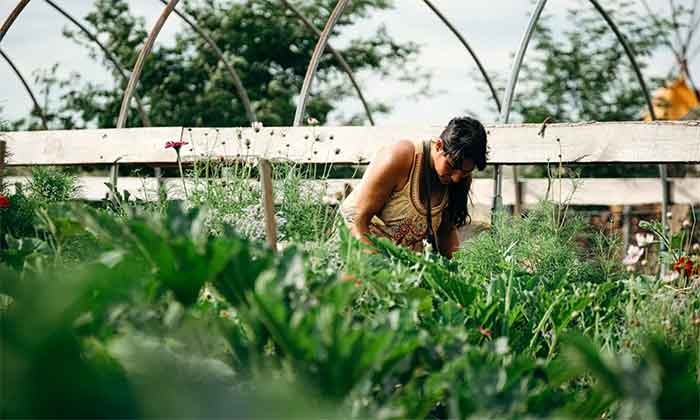
What will life be like after peak oil, in an age of major climate shifts? Hollywood movies often depict it as a bleak, dystopian world where each day is a struggle to survive after every system we depend on has been stripped away.
Unfortunately, that version of the story seems to be on track so far. Despite mounting scientific consensus on everything from the rate of polar ice melt to the increase in disastrous fire and weather events, the collective human response to the climate emergency has been, to put it mildly, underwhelming.
Governments and institutions fail to take truly effective action, miss emissions targets, or deny the issue outright. Individual responses range from blind faith that a technological miracle will occur to bringing reusable bags to the grocery store. Even as it becomes clear that the age of cheap energy and throwaway culture must end, many of us are still metaphorically hiding under the covers.
But what if, instead, a post-peak-oil lifestyle was something we aspired to? It’s a radical idea that involves reimagining existing societal structures and what constitutes progress. The Transition movement is built around this concept; it’s a worldwide web of local, community-based efforts to reduce fossil fuel reliance and relocalize economies. The structure of the Transition model reflects older values, mirroring the traditions of community-based self-reliance found in many Indigenous cultures. Transition also weaves the threads of the modern-day permaculture, homesteading, DIY, and maker movements into a cohesive vision of strong, resilient, connected communities that can mitigate and survive climate change.
“The environmental field, in general, takes a technocratic approach: ‘We have all the right technology, and we just need the right policies and politicians,’” says Asher Miller, the executive director of the Post Carbon Institute and a Transition U.S. board member. “Transition has a larger view of the problem: It’s not just climate. That may be the symptom that kills us, but it’s just a symptom.”
A core tenet of the Transition movement is that people would be happier with more community and less cheap energy (and the culture of stuff that it fuels). But it’s going to take a major shift of both systems and minds to get there.
Miller says, “Transition is the transformation that we all need to make, because the way we’re living is unsustainable and unsatisfying.”
Refreshing Honesty
The Transition movement was founded in the U.K. in 2005 by environmental activist and author Rob Hopkins, who outlined in his Transition Handbook a utopian vision of fossil-fuel-free communities. Rather than an apocalyptic future, Hopkins provided a detailed, hopeful blueprint of what life after peak oil could be.
“Transition was the first environmental movement that spoke honestly about the inevitability of climate change,” says Leslie MacKenzie, who helps run Transition Twin Cities. “It gives people accurate information and tools and community to deal with it.”
The concept spread rapidly, both within the U.K. and abroad. In the dozen or so years since Transition made the trans-Atlantic leap to the United States, initiatives have sprouted from California to New York. More than 100 community-based efforts now exist across the country. Transition groups can be town- or citywide, or, in more densely populated areas, neighborhood-based. Each group undertakes different activities, depending on the needs of the local community. The national organization, Transition U.S., provides training and administrative support to local efforts.
Transition Twin Cities is a loose network of neighborhood-based Transition organizations throughout St. Paul and Minneapolis, Minnesota. Their work has taken root and spread in unexpected ways, seeding a complex tree of localized climate change resilience projects. In Saint Anthony Park, a neighborhood of about 8,000 people in northwest St. Paul, for example, Transition efforts led to the birth of an affiliated group called Transition Your Money.
“We wanted to explore all the different ways we can break the system that’s keeping all our money in Wall Street,” says Pat Thompson, one of the offshoot’s founders. One result is a community investment group called Local Dough. Each month, its 23 members pool their contributions to invest in local businesses that support community and sustainability. Their first two investments are solar projects. The first, Cooperative Energy Futures, is a community energy cooperative that builds solar gardens atop urban structures. The second, a solar development project by the Red Lake Nation, is designed to help the tribe achieve off-the-grid energy independence.
Another subgroup of Transition Your Money members (including Thompson) founded a new 3,000-square-foot community center and coworking space called CoCreatz. Located in a historic commercial district between St. Paul and Minneapolis, the center is near both public housing and a light rail line to make it accessible to under-resourced communities.
In Berkeley, California, Transition efforts have taken a different shape. Founder Linda Currie says, “Before Transition, we weren’t connecting resources to people or each other. The Ecology Center, the university, the Sierra Club, the city—there was a web that was missing. By starting Transition Berkeley, I felt it would be a way to connect all these groups.” Currie and Bonnie Borucki have since incorporated Transition Berkeley as a nonprofit, and the group’s work now includes pollinator gardens, local government advocacy, and repair events.
Their grant-funded Repair Cafés, held multiple times each year, play a core role in helping the community move away from a culture of disposability. At their November 2019 event, almost 90 people brought broken items, ranging from appliances to bikes to computers, and roughly 30 skilled repair volunteers got to work. The Repair Café events achieve “fix rates” between 65 and 86%. In 2019 alone, they kept close to 760 pounds of household items out of landfills.
The Challenges of Inclusivity and Growth
Despite the success stories, the Transition movement has lost some of its steam in the United States. A number of the original groups have gone defunct. That’s in direct contrast to other countries, where the movement is still rapidly expanding. Pamela Boyce Simms, who worked with Transition U.S. for six years as a trainer and convener says, “Here we are in 2020, with Siberia and Australia and California burning, climate disruption and crop cycle disturbances everywhere. Why has the Transition movement not deepened? We need to take a deep look inside ourselves.”
Cultural differences may help explain why the Transition movement has gained more traction in other countries. Boyce Simms, who now works on projects ranging from the African Diaspora Earthcare Coalition to a resilience network she calls Community-Supported Enlightenment, says, “In the U.K. and in other places, where there’s a sense of community, where the communal is embedded in the DNA of society, it works. In the U.S., because of the culture of individuality and competition, it’s harder. It’s just the way the U.S. works. It’s in the air we breathe.”
Another constraint for the Transition movement—one it shares with other environmental movements—is that participants who have the time and the resources to focus on the work tend to be White and affluent. Communities of color and low-income groups are often on the fringes, if they’re included at all. But many of those same communities will be disproportionately affected by climate change and are most in need of community-based resilience strategies.
“There’s a certain privilege of time that people need have to be able to consider these issues,” says Miller, Transition U.S. board member. “You find this in the environmental movement in general: You see retirees; you see students. If you’re a family struggling financially, finding the headspace for this work is hard.”
Boyce Simms has a different assessment of inclusivity within the Transition movement: “At the national level, there was no effort to include people that didn’t look like them,” she says. “At the local level, the interest might be there in terms of doing the right thing—these are good people who are focused on the right things—but people often didn’t know how.”
Hope in Action
Efforts to combat exclusivity are gaining ground. Transition Berkeley now collaborates with Church by the Side of the Road. Their pastor, the Reverend Dr. Ambrose Carroll, helps lead Green the Church, an internally driven effort to help Black churches become more sustainable. As a first step, Transition Berkeley and the church held a Community Climate Healing Circle in the Fall of 2019 to acknowledge the issue of inclusivity and create a welcoming space. They are now partnering to develop a variety of events and activities around Earth Day.
Other historically marginalized communities are being approached through active outreach. In South Dakota, Bryan Deans, a member of the Lakota tribe, connected with the movement when Transition U.S. asked for more information about the energy self-reliance projects he was implementing in his community. “A lot of what I do is remembering Lakota ways and then transitioning back to them,” he says. “There’s only so many trees you can cut. There’s only so many minerals you can extract.”
Deans founded the Oglala Lakota Cultural & Economic Revitalization Initiative to restore his tribe’s traditional self-sufficient and community-based way of life. Now under construction, their off-grid site on the Pine Ridge Reservation will include a food production and storage system, generational housing, solar and wind power, and a community center designed to preserve Indigenous wisdom and history.
At its core, the modern-day Transition movement seeks to replicate the same community structures, self-sufficiency, and resilience that Deans is helping rebuild for his tribe. And while the future growth of the U.S.-based Transition movement may be uncertain, it’s not going away anytime soon. More than 100 groups are active in the U.S. today, and many efforts incubated by Transition have since spun off and grown.
The movement’s powerful combination of unflinching honesty about climate change combined with community-based blueprints on how to mitigate it resonates deeply with people. And the vision—that a community without fossil fuel dependence is something to strive for rather than panic about—brings a rare spot of hope to a gloomy landscape.
“It’s the antidote to fear,” MacKenzie of Transition Twin Cities says. “We have this huge change coming. How can we live our best lives possible in community?”
Samantha Nobles-Block is a San Francisco Bay Area-based freelance writer. She is a monthly columnist for the San Francisco Chronicle’s Culture Desk, and her work has appeared in San Francisco Magazine, Hyperallergic, Heated Magazine and Edible East Bay, among others. You can read more of her work at www.SNBwords.com.
Originally published by YES! Magazine
GET COUNTERCURRENTS DAILY NEWSLETTER STRAIGHT TO YOUR INBOX















































